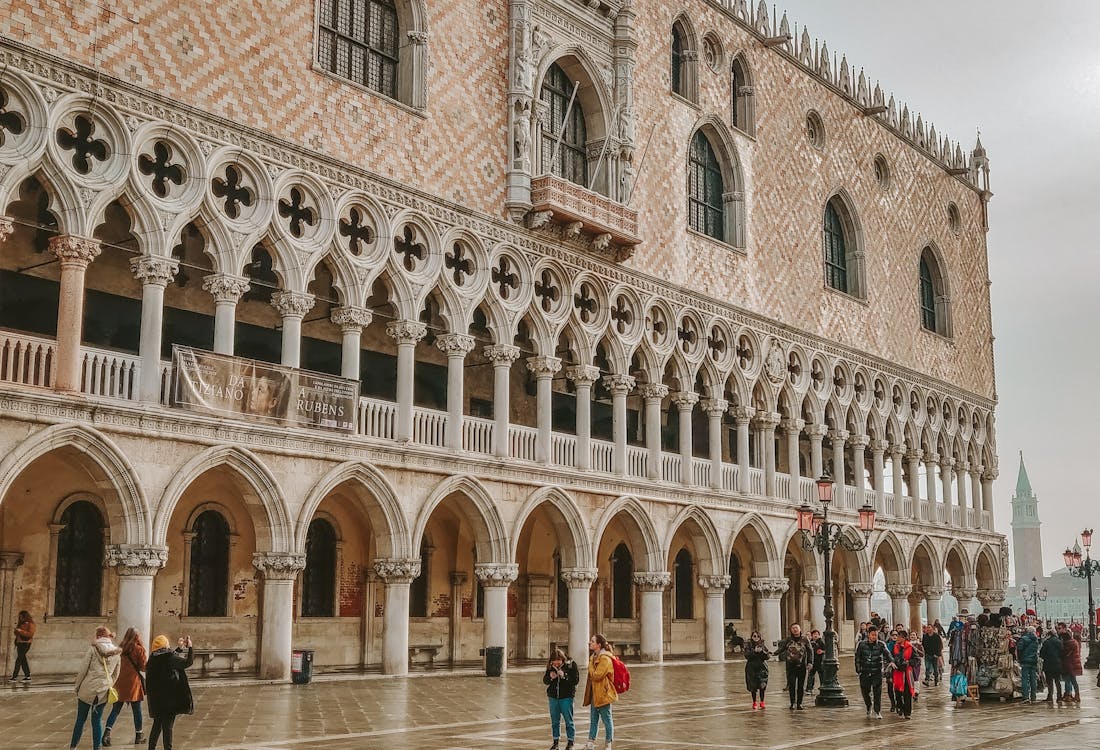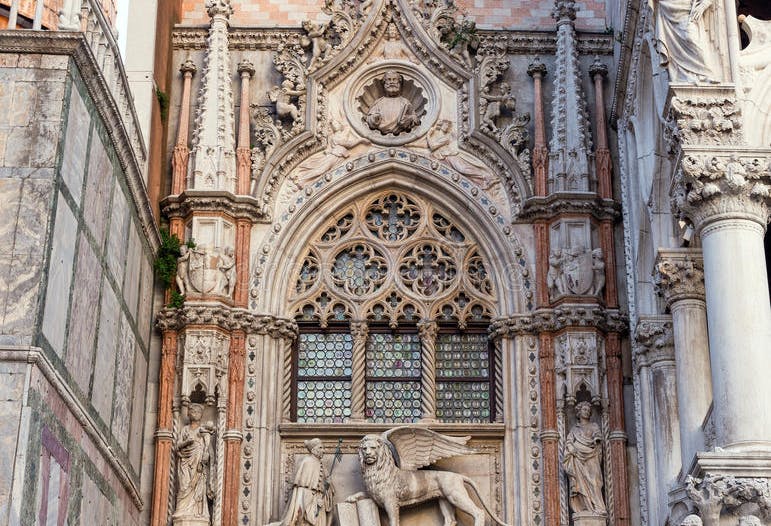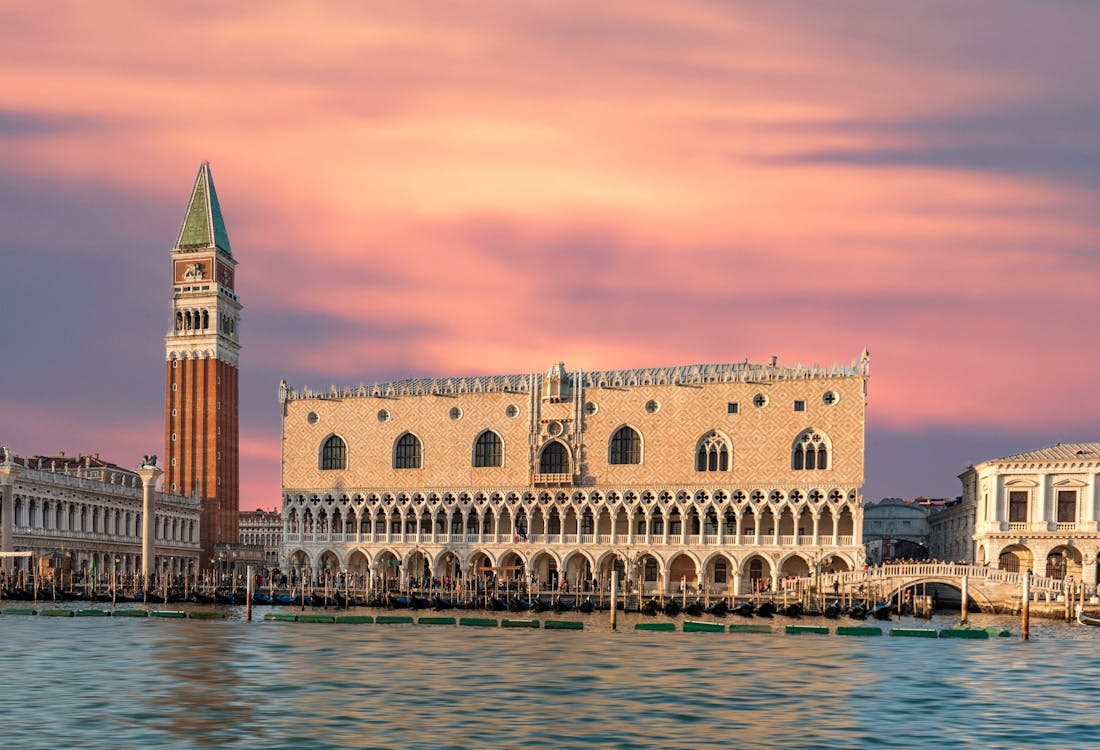The Doge's Palace in Venice stands as a magnificent testament to the wealth and power of the Venetian Republic. It served as the residence of the Doge, the elected leader of the Republic, and was the center of government and justice. Its Gothic architecture and sheer grandiosity symbolizes the city’s past splendor. Today, it remains an iconic landmark and museum, housing artistic masterpieces and telling tales of Venice's political and cultural history.
Doge's Palace: In a nutshell
Handy information
| ⏰ Suggested Duration: | 2.5 hours |
| ☀️ Best Time to Visit: | Early morning |
| 💜 Must-see: | Doge's Apartments |
| 🎟️ Doge's Palace tickets | €30 |
Must-see
Museo dell'Opera
Bridge of Sighs
The Chamber of the Great Council
The "Scudo" Room
Things to know
Established in: 1340
Location: Venice
Architect: Filippo Calendario and Giovanni Bon
Architectural style: Venice Gothic Architecture
Opening Hours And Address
Daily 9 AM to 10 PM
Wednesday 9 AM to 6 PM
Address: P.za San Marco, 1, 30124 Venezia VE, Italy
Get Directions
The Doges of Venice
Doge is Venetian Italian word for “Duke” derived from Latin Dux which translates to “leader”. The Office of Doge first emerged with Paolo Lucio Anafesto in the 8th century during the Byzantine Empire and was an integral ruling body in the La Serenissima till the 18th century.
Know the Doges of Venice
In total 120 doges ruled the Venetian Republic. The elaborate selection process ensured that no single individual could wield absolute power, reflecting the Republic's complex governance system designed to balance control among the elite families.
- Francesco Foscari , elected in 1423 reigned for 34 years making him the Doge who held his position for the longest period
- Francesco Cornaro the 101st Doge on the other hand was the Doge who reigned for the shortest period of 35 days.
- Enrico Dandolo, the 41st Doge is considered the most famous and loved Doge. He was a vision impaired yet led the contingent for the Sack of Constantinople at 90 years of age. He is all the more renowned for his role in the Fourth Crusade which freed Venice from the shackles of Greek Byzantine Empire.
- Marin Faliero, the 55th Doge was elected in 1354 at the age of 76 and remains the only Doge to have been arrested and beheaded for treason. His plot for revolvting against the ruling patricians and subsquent tragic death has inspired several important literary works, like 'Marino Faliero, Doge of Venice' , a blank verse tragedy in five acts by Lord Byron.
- Ludovico Manin was last Doge of Venice and was abdicated when Napoleon arrived in Venice in 1797 thus putting an end to the thousand-year tradition.
The Doge's Palace - A brief History
The Palazzo Ducale, as it's known in Italian, was built in the 14th century, incorporating previous fortified structures that existed on the site. Over the centuries, it was repeatedly expanded and embellished to reflect the prosperity and influence of Venice. The façade facing the lagoon is famously adorned with a pattern of diamond-pointed marble work, which adds to the palace's aura of elegance. The building has withstood the trials of time and even severe structural damages from multiple fires.

Inside Doge’s Palace - What to see?
The interiors of Doge’s palace scream opulency. Ornate furnishings, Venetian art pieces and lavish rooms are all a sight behold. This palace houses administrative offices, judicial chambers, the Doge’s private apartments, ballrooms, courtyards, grand stairways, and prisons in its ground floor.
Puerta della Carta

The flamboyant Gothic styled main entrance of the Doge’s Palace designed by Giovanni Bon and Bartolomeo Bon is bound to leave you mesmerised before even stepping foot into the Palace. Puerta della Carta which translates to "Paper Gate" is the entrance gate between the Doge's Palace and St Mark's Basilic with a sculpt of Francesco Foscari ( the ruling Doge during its construction ) kneeling before the Lion of St. Mark perched on top of the grand entrance.
Foscari Arch
Once you enter through the Porta della Carta, you will see a a beautiful triumphal arch adorning scuplts of Adam and Eve. This Gothic spired arch was designed by Antonio Rizzo and is a fine piece of art.
Giant Staircase (Scala dei Giganti)

From the coutyard, you will see a godly stretch of serpentining stairs called the Giant's Staircase built by the famous Sansovino. It is flanked by statues of two huge statues of Mars and Neptune symbolizing Venice's authority over land and sea.
Golden Staircase (Scala d'Oro)
Gilded with gold , this lavish staircase was built over a period of 29 years so as to provide a grand entrance to the dignitaries and magistrates visiting the Doge's Apartment on the upper floor.
Chamber of the Council of Ten (Sala del Maggior Consiglio)
This is the grandest and largest room in the Doge’s Palace, measuring nearly the entire length of the southern facade with a capacity of holding around 1000 individuals at a time. The Sala del Maggior Consiglio is where Venetian patrician families gathered to discuss matters regarding the Republic. Though the Doge was considered the leader of the Venetian Republic, he was not allowed to make decisions without the approval of the Council of Ten. Consiglio dei Dieci ( Council of Ten) is said to have been set up after 1310, Bajamonte Tiepolo along with other noblemen tried to overthrow the state. The Council of Ten was formed to support the Doge and were an constitution of 10 ultra-powerful influential Venetians who held power on par with the Doge. Democracy is said to have been practised within these 4 walls long before the political term made its way to the Oxford dictionary. In this room, you will catch a glimpse of fading frescos of the first 76 Doge’s of Venice , except that of the infamous Marin Faliero. However, the most impressive decor here is the Tintoretto’s painting called “Paradiso” , the world’s largest canvas painting.
Courtrooms (Sala del Magistrato alle Leggi)
Since Italy had its own legislative system, the Doge’s Palace has its own courtrooms where laws were made, reformed and discarded. Here you can lay your eyes on a beautiful triptych of Hieronymus Bosch.
Chambers of the Doge (Appartamento Ducale)
The personal space of the Doge might seem small and humble, but it was kept this way for a reason. Though he held authoritative power, he was a minister of the state. Hence, he had to maintain simplicity. In the Doge’s Chamber you will see a collection of land cards that shows the actual size of the Venetian Republic. You will also see two giant world globes that show how the 18th century worldview.
Armory room (Armeria di Palazzo)
Since Venice was dominating the maritime trade routes in Europe, the Doge’s Palace had a stock of ammunition to deter any threats. This was stored in the armory room and today we can see an array of arms and ammunition that was used then. You will find swords, crossbows and harnesses, and the most innovative of all, the “Devil’s chest”. This is a unique ammunition that you are not likely to have seen elsewhere. It is a booby trap of 4 guns and poisonous arrows that will blow open the attacked persons chest.
Secret rooms (Stanze segrete)
There are many secret rooms in the Doge’s palace which were basically interrogation rooms and cells. The smaller cells built under lead roofs which housed criminals were called “pozzi” and the more comfortable cells which housed pristine prisoners were called “piombi”. Legend goes that Casanova escaped from one of these piombis.
New Prison and Bridge of Sighs (Prigione Nuovo and Ponte dei Sospiri)
When the Rialto Bridge was constructed, a decision was made to shift the prison cells from the Doge’s palace to an adjacent building on the opposite side of the canal. In order to transfer the criminals from the interrogation rooms in the Doge’s Palace to the new prison, a bridge was constructed and named the Bridge of Sighs. The dark name of the bridge slingshotted it to fame very soon after its construction. Apparently, the prisoners were catching their last glimpse of beautiful Venice before crossing over to the other side and all they could do was sigh, hence the name.
Doge's Palace Tickets
Doge's Palace - Practical Information
Open Hours and Timings
From 01 November to 31 March: 9.00 – 18.00 (last entry 17.00) From 01 April to 31 October: 9.00 – 19.00 (last entry 18.00) Museum closing operations begin 30 minutes before the indicated time- From 1st November to 31st March: 9 AM to 6 PM. Last entry at 5 PM.
- From 1st April to 31st October: 9 AM to 7 PM. Last entry at 6 PM
- From 8th February till 13th February 2024 for the occasion of Venice Carnival Doge's Palace will operate from 9 AM to 10 PM
Getting There
Reaching Doge's Palace by Public Vaporetto
If you are taking line #1 and get off at “San Marco Vallaresso”. If you are taking line #2 and get off at “San Marco Giardinetti”. After you alight, walk to Saint Mark’s Square. Once here, look for the Bell Tower and diagonal to it you will find the Doge's Palace
Reaching Doge's Palace by Private Watertaxi
Ask the driver to take you to the “Todaro” landing stage. Once you alight, walk to Saint Mark’s Square. Once here, look for the Bell Tower and diagonal to it you will find St. Mark's Basilica
Reaching Doge's Palace on Foot
Reaching the St. Mark's Square is fairly easy. Look for the tall Bell Tower once you are here and diagonal to it you will find the St Mark's Basilica.
Doge's Palace during Venice Carnival
During the Venice Carnival, the Doge's Palace takes on a new level of enchantment. The historic ambiance of the palace combined with the vibrant festivities, masks, and costumes create an unforgettable backdrop. There’s a scavenger hunt for kids designed to uncover the mysteries of Venice's past which winds through the palace's halls. During this time, the palace is not just a relic of history but becomes a stage for the reenactment of the city’s glorious past, offering visitors a glimpse into the illustrious life of Venetian nobility and the unique traditions that have shaped this enchanting city over the centuries.
Doge's Palace - Insider Tips
- The best time to visit the Doge's Palace in the morning soon after it opens, preferably on weekdays. This helps you beat the crowd and queues.
- Photography is not allowed in most rooms, flash photography specially is strictly prohibited.
- Last admission is one hour before the closing time. Plan to spend atleast 2 hours inside the Palace for a fulfilling visit.
- There is a quite a bit of walking involved, so be sure to strap on a pair of comfortable footwear.
- The secret itineraries tour is highly recommended for gaining access to rooms that are not a part of the usual guided tour. You should consider booking your tickets online as their daily timings are slightly different.
- An economical deal would be buying the Museum Pass which will give you access to the Doge’s Palace and 10 other museums in Venice or the St. Mark's City Pass which gives you access to the Doge's Palace along with a selection of churches, museums and more.
- It is highly recommended that you visit the Bookshop and Cafe inside the Doge's Palace.
- While the Doge's Palace is fully wheelchair accessible, the Secret Itineraries Tour, New Prisons and Armoury Room are not wheelchair accessible. Do take this into consideration while booking your tickets.

